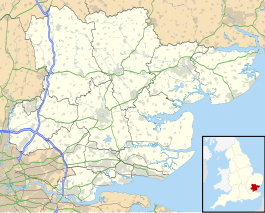Theydon Bois tube station: Difference between revisions
TfLstyle |
|||
| Line 41: | Line 41: | ||
}} |
}} |
||
'''Theydon Bois''' is a [[London Underground]] [[metro station|station]] in the village of [[Theydon Bois]] in [[Essex]], [[England]]. It is served by the [[Central line (London Underground)|Central line]] and is between [[Debden tube station|Debden]] and [[Epping tube station|Epping]]. For the purposes of fare charging it is in Zone 6. |
'''Theydon Bois''' is a [[London Underground]] [[metro station|station]] in the village of [[Theydon Bois]] in [[Essex]], [[England]]. It is served by the [[Central line (London Underground)|Central line]] and is between [[Debden tube station|Debden]] and [[Epping tube station|Epping]]. For the purposes of fare charging it is in Zone 6. |
||
{{TfLstyle|id=6|heritage=}} |
|||
==History== |
==History== |
||
Revision as of 23:02, 20 July 2019
| Theydon Bois | |
|---|---|
 Station entrance | |
| Location | Theydon Bois |
| Local authority | District of Epping Forest |
| Managed by | London Underground |
| Number of platforms | 2 |
| Accessible | Yes (Eastbound only)[1] |
| Fare zone | 6 |
| London Underground annual entry and exit | |
| 2019 | |
| 2020 | |
| 2021 | |
| 2022 | |
| 2023 | |
| Key dates | |
| 24 April 1865 | Opened |
| 25 September 1949 | London Underground services start[7] |
| 18 April 1966 | Goods yard closed[8] |
| Other information | |
| External links | |
| Coordinates | 51°40′18″N 0°06′12″E / 51.67166°N 0.10333°E |
Theydon Bois is a London Underground station in the village of Theydon Bois in Essex, England. It is served by the Central line and is between Debden and Epping. For the purposes of fare charging it is in Zone 6.
History
The station was opened as "Theydon" by the Great Eastern Railway (GER) on 24 April 1865 but in December that year it was renamed to its present name. It opened as an intermediate station on their Loughton–Ongar extension; the GER became part of the London and North Eastern Railway (LNER) in 1923. 'Milk trains' to Liverpool Street were a regular feature in the timetable until the underpass from Leyton to Stratford was built.
As part of the New Works Programme, 1935–1940, the LNER branch was transferred to London Underground, to form the part of the eastern extension of the Central line.
In 2015, advocacy by a local group forced a proposed 80-space commuter car park to seek planning permission before being constructed on land adjacent to the station.[9]
The station today
The station was one of the first on the Underground network to operate without a staffed ticket office.[citation needed]
Gallery
-
Westbound platform looking north (eastbound) towards Epping
-
Eastbound platform looking south (westbound) towards central London
-
Looking north from public footbridge
-
Station platform roundel
References
- ^ "Step free Tube Guide" (PDF). Transport for London. April 2021. Archived (PDF) from the original on 15 May 2021.
- ^ "Station Usage Data" (XLSX). Usage Statistics for London Stations, 2019. Transport for London. 23 September 2020. Archived from the original on 9 November 2020. Retrieved 9 November 2020.
- ^ "Station Usage Data" (XLSX). Usage Statistics for London Stations, 2020. Transport for London. 16 April 2021. Retrieved 1 January 2022.
- ^ "Station Usage Data" (XLSX). Usage Statistics for London Stations, 2021. Transport for London. 12 July 2022. Retrieved 7 September 2022.
- ^ "Station Usage Data" (XLSX). Usage Statistics for London Stations, 2022. Transport for London. 4 October 2023. Retrieved 10 October 2023.
- ^ "Station Usage Data" (XLSX). Usage Statistics for London Stations, 2023. Transport for London. 8 August 2024. Retrieved 16 September 2024.
- ^ http://art.tfl.gov.uk/labyrinth/artwork/theydon-bois/
- ^ Hardy, Brian, ed. (March 2011). "How it used to be - freight on The Underground 50 years ago". Underground News (591). London Underground Railway Society: 175–183. ISSN 0306-8617.
- ^ Blow to TfL in row over commuter car park, Joseph Flaig, 6 August 2015. Archived 4 March 2016 at the Wayback Machine
External links
- Use dmy dates from August 2012
- Rail transport stations in London fare zone 6
- Central line stations
- Proposed Chelsea-Hackney Line stations
- Tube stations in Essex
- Transport in Epping Forest District
- Former Great Eastern Railway stations
- Railway stations opened in 1865
- London transport stubs
- United Kingdom rapid transit stubs





